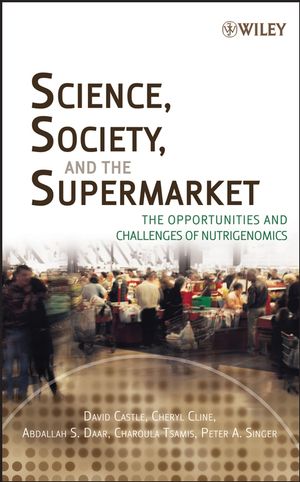Science, Society, and the Supermarket: The Opportunities and Challenges of NutrigenomicsISBN: 978-0-471-77000-8
Hardcover
163 pages
December 2006
 This is a Print-on-Demand title. It will be printed specifically to fill your order. Please allow an additional 10-15 days delivery time. The book is not returnable.
|
||||||
Acknowledgments.
1 NUTRITIONAL GENOMICS: OPPORTUNITIES AND CHALLENGES.
1.1 Introduction.
1.2 What is Nutritional Genomics?
1.3 Methodology and Approach of this Book.
1.4 Opportunities and Challenges for Nutrigenomics.
1.4.1 Improved health.
1.4.2 Personalized dietary advice.
1.4.3 Improved diet.
1.4.4 More development of health-enhancing food products.
1.4.5 Consumer empowerment.
1.4.6 Reducing health disparities.
1.4.7 Health care savings.
1.5 Challenges and a Road Map of This Book.
References.
2 THE SCIENCE OF NUTRIGENOMICS AND NUTRIGENETICS.
2.1 Introduction.
2.2 The Scientific Context.
2.2.1 Nutrigenomics.
2.2.2 Nutrigenetics.
2.3 The Case of MTHFR.
2.4 Room for Improvement.
2.4.1 Study design.
2.4.2 Epigenetics.
2.4.3 SNPs and haplotypes.
2.4.4 Dietary intake assessment.
2.4.5 Biomarkers.
2.4.6 Susceptibility and predictions.
2.4.7 Analytical and clinical validity.
2.4.8 Clinical utility.
2.5 Science and Technology Assessment.
2.6 Conclusion.
References.
3 THE ETHICS OF NUTRIGENOMIC TESTS AND INFORMATION.
3.1 Introduction.
3.2 Ethical Principles.
3.3 Nutrigenomics Testing in the Clinical Setting.
3.3.1 Informed consent.
3.3.2 Confidentiality.
3.3.3 Secondary information.
3.3.4 Families.
3.3.5 Genetic testing of children and adolescents.
3.4 Use of Nutrigenomics Information for Research.
3.5 Use of Nutrigenomics Information by Private Third Parties.
3.5.1 Insurance.
3.5.2 Employment.
3.5.3 Legal and social responses to fears of discrimination.
3.6 Conclusion.
References.
4 ALTERNATIVES FOR NUTRIGENOMIC SERVICE DELIVERY.
4.1 Introduction.
4.2 Considerations for Nutrigenomic Service Delivery.
4.2.1 Strength of the science.
4.2.2 Regulatory environment.
4.2.3 Human resource capacity and professional competence.
4.2.4 Funding policy.
4.2.5 Professional politics and culture.
4.2.6 Consumers and patients.
4.3 Four Alternative Models.
4.3.1 Consumer model.
4.3.2 Health practitioner model.
4.3.3 Blended models.
4.3.4 Public health model.
4.4 Conclusion.
References.
5 NUTRIGENOMICS AND THE REGULATION OF HEALTH CLAIMS FOR FOODS AND DRUGS.
5.1 Introduction.
5.1.1 Genetic tests, service delivery, and genetic antidiscrimination.
5.2 Food Categories: Functional Foods, Nutraceuticals, Medicinal Foods, and Dietary Supplements.
5.2.1 Functional foods.
5.2.2 Nutraceuticals.
5.2.3 Medical or medicinal foods.
5.2.4 Dietary supplements.
5.3 Health-Related Claims Associated with Foods Compared to Drugs.
5.3.1 Structure–function claims.
5.3.2 Health claims.
5.3.3 Medical food claims.
5.3.4 Disease risk reduction claims.
5.4 Nutrigenomic Information and the Regulation of Foods Compared to Drugs.
5.4.1 The regulation of foods.
5.4.2 The regulation of drugs.
5.5 Food and Drug Regulations in Japan, the United States, and Canada.
5.5.1 Japan.
5.5.2 United States.
5.5.3 Canada.
5.6 Conclusion.
References.
6 NUTRIGENOMICS: JUSTICE, EQUITY, AND ACCESS.
6.1 Introduction.
6.2 Industrialized Country Context.
6.2.1 Individualized nutrigenomic testing.
6.2.2 Population-based nutrigenomics.
6.3 Developing Country Context.
6.3.1 Individualized nutrigenomic testing.
6.4 Nutrigenomics and Intellectual Property.
6.4.1 An issue of access to scientific information.
6.5 Conclusion.
References.
7 CONCLUSIONS AND RECOMMENDATIONS.
7.1 Introduction.
7.1.1 Nutrigenomic science.
7.1.2 Nutrigenomics and health information management.
7.1.3 Nutrigenomic service delivery.
7.1.4 Regulation of nutrigenomics.
7.1.5 Access and equity.
7.2 A Final Word.
Index.



